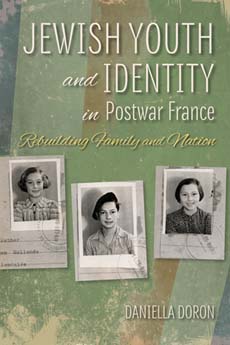As Vichy police and German forces rounded up Jews in France, deporting them to Nazi concentration camps in Poland, thousands of desperate Jewish parents placed their children with non-Jewish families or Christian institutions, hoping they would be reunited with them after the war. Thirty thousand children survived the Nazi occupation. One-third of them, having been hidden, were the objects of a massive search after the liberation of France. Following the murder of some 75,000 French Jews during the Holocaust, they were regarded as the future of the depleted Jewish community.
As Daniella Doron writes in Jewish Youth and Identity in Postwar France (Indiana University Press), a straightforward and dry account of this issue, the catastrophic demographic losses incurred by French Jewry prompted Jewish organizations to comb cities and the countryside for Jewish children who had survived the Holocaust. “The history of efforts to reintegrate postwar Jewish children reveals that a popular embrace of Jewish ethnicity, communal comity and an early articulation of Holocaust memory emerged on the French stage immediately at war’s end,” says Doron, a lecturer in Jewish history at Monash University in Australia.

Placing the issue in its larger context, Doron points out that while 330,000 Jews lived in France on the eve of World War II, only one-third were actually French citizens. The so-called foreign Jews were the chief victims of Vichy and Nazi oppression. Twenty four thousand French Jews, including naturalized citizens and children of foreign parents, were also murdered during this period.
“French society held a range of opinions, from dissent, to assent, to indifference, about the persecution and deportations,” she notes.
French resistance organizations, possessing a sophisticated and covert network of social workers and host families, were in the forefront of helping Jews find hiding places for their children. “Whether hidden by families or agencies, Jewish children routinely adopted French Christian names and, no matter their age, had to adhere to a fictional biography,” she adds. “In the meantime, child welfare and resistance agencies guarded children’s true names and identities lest young children forget their personal pasts.”
These children were subjected to psychological duress and trauma, having to accustom themselves to the reality that their parents would never return and having to adapt to new step-parents.
Even before the war ended, the main Jewish child welfare organizations regrouped in major cities to coordinate the search for and care of Jewish youth. It was feared that the children, perceived as symbols of Jewish continuity, may have been influenced by Christianity and lost to the Jewish community.
There were indeed custody battles in instances when Christian foster parents sought to preserve the integrity of families that had been cobbled together during this dark era. “Some foster families maintained that a loving family — whatever its faith or ethnicity — best served a child’s interests,” says Doron.
One Jewish welfare organization discovered that 48 percent of the children who had been hidden suffered from malnutrition, respiratory problems or anemia, and had fallen one or two academic years behind their Christian peers.
In the effort to reunite children with parents, or to place them in Jewish orphanages, countless Jews took extraordinary measures. They pursued time-consuming judicial and bureaucratic procedures, engaged in kidnappings and paid what amounted to ransoms.

The interim chief rabbis of France, Jacob Kaplan and Henri Schilli, were assigned to the task of conveying this problem to the Roman Catholic Church. “The church hierarchy, and particularly the papacy, remained conspicuously silent and evasive throughout these events,” writes Doron. “While the papacy did not condone illegal kidnappings and forced baptisms, it nonetheless considered a baptism theologically sacrosanct and irreversible.”
The abrupt return of surviving parents and other relatives to reclaim hidden children often ended on a joyous note. But in other cases, says Doron, young lives were destabilized, causing intense familial resentment and strife.